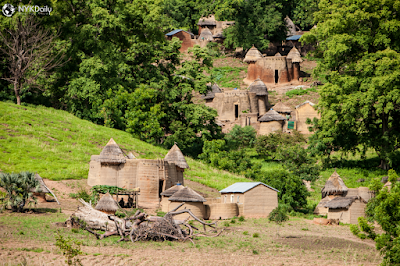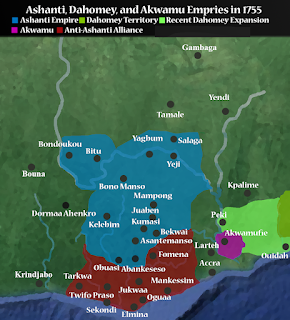In 1763, war broke out between the Ashanti and Dahomey empires. These two empires, the most important states in the region of modern Ghana, Togo, and Benin, clashed at the small village of Atakpame. The result would forever change both empires.
In 1763, the Dahomey was still a relative newcomer as a great power. The empire's capital of Abomey began expanding into neighboring regions around 1720, and would eventually seize control of the Akwamu empire's easternmost vassal: the coastal city state of Ouidah. The Akwamu, preoccupied with internal disputes and numerous other wars, were unconcerned with this rising power to their East. However, after a brief lull in expansion, the Dahomey once again pushed west towards Akwamu. In the 1740s, they destroyed the formerly significant kingdom, reducing its area of influence only to its capital city of Akwamufie.
While Dahomey expansion concerned the Ashanti, it possessed little priority compared to other, more pressing issues. Namely, the southern states of Twifo, Fante, Akyem, and Wasa, as well as their vassal kingdoms, united into an alliance to combat Ashanti influence in the south of Ghana. Together, they formed a significant bulwark. However, the Ashanti managed to take advantage of disunity in this faction, declaring war on the Akyem and occupying much of their lost territory. The Ashanti, however, soon recognized evidence for Dahomey support for these rebellions. The unpopular and elderly Ashanti king, Kusi Obodom, was pressured by the Juabenhen, Odankua, into declaring a punitive war against the Dahomey.
Odankua would lead this expedition, and formulated a simple plan: march an army straight into the Dahomey capital city of Abomey, show Ashanti strength, and then retreat having sent a message of not messing with the Ashanti. Convinced that the Dahomey would not be capable of mounting any serious resistance, Odankua's army marched hastily through the Dahomey's recently conquered territories. Encountering no opposition, the Ashanti army stopped to rest at the village of Atakpame before they would continue their march to the capital.
 |
| Today, Atakpame is a tranquil town in the Togo countryside. In 1763, it was the site of a major battle. |
However, upon waking the next day, the Ashanti army was startled to encounter a vast force of not only the Dahomey army, but also forces from the empire of Oyo, a state from modern day Nigeria, and allied regiments from the anti-Ashanti alliance in southern Ghana. Included among these forces was the Mino, also known as the "Dahomey Amazons." This all-female force would prove decisive in the engagement, exploiting a break in the Ashanti lines to chase them back to Kumasi in a bloody retreat. Throughout this pursuit, the Dahomey and their allies captured or killed most of the Ashanti army, including Odankua himself. This battle would go down as the worst defeat in Ashanti history until this point, and would retain this status for the rest of the 18th Century.
In the end, the battle and its fallout would change Ashanti history. The ailing king Obodom was impeached from power, and a new king would have to be elected. And, while the Dahomey's conquests in the west would not last long, the defeat of the Ashanti at Atakpame would always remain a point of pride for the empire's inhabitants.


Not sure where to put a general comment, but wanted to say I just found you & am quite happy about it!thank you & please keep it going. I already learned good bit just from your first episode!
ReplyDelete